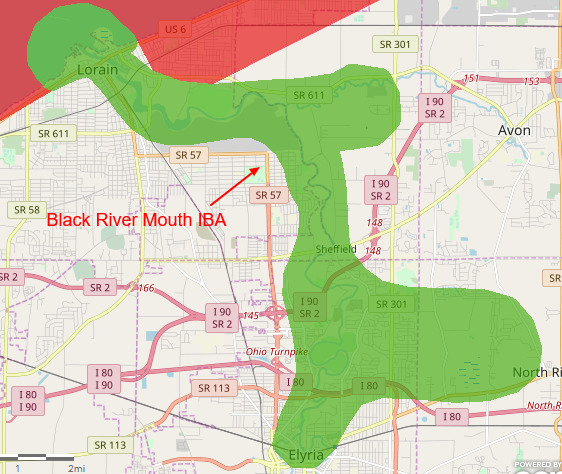Black River Mouth Important Bird Area
Black River Mouth
Important Bird Area
Explore in eBird
Entire Year – Spring – Summer – Fall – Winter
Locations
Lorain
Black River Audubon Society Park
Black River Landing
Black River Reservation--Bridgeway Trail
Black River Reservation--Bur Oak
Black River Reservation--High Meadows
Black River Reservation--Steel Mill Trail
Black River Wharf Boat Launch
Black River, Lorain
Cascade Park, Elyria
Cromwell Park
Elywood Park
Finwood Forest Park, Findley Cabin
French Creek Reservation
French Creek Reservation--Burrell Homestead (restricted access)
French Creek Reservation--Nature Center
French Creek Reservation--Pine Tree Picnic Area Entrance
Lorain Harbor--Boat Ramp Hotwaters
Lorain Harbor--Breakwalls
Lorain Harbor--Fishing Pier
Riverside Park, Lorain
Sandy Ridge Reservation
Spitzer Riverside Marina

About Black River Mouth Important Bird Area
The Black River Mouth Important Bird Area includes the Lorain harbor, with surrounding break walls, marinas, fishing areas, intermittent hot-water outlet, sandflats, beach, city park, and dredge impoundment (inactive). The impoundment is a semicircular area enclosed by a rock wall, a cement pier, and a slight slope up to a roadway. A marina and the Black River are adjacent to the pier. Beyond the slope are a steep bluff and the residential and commercial areas of the city of Lorain. The impoundment includes small groups of trees with some adjacent cattails, etc. The added value of this site is the accessibility by the public. For decades this site has attracted a steady stream of bird watchers.The harbor is a massive foraging site in late fall-early winter for Red-breasted Mergansers and Bonaparte’s Gulls. It is used again in spring by Red-breasted Mergansers: offshore areas support 30,000 in spring migration, as much as 5% of the global population estimated to be 510,000-600,000 individuals (Wetlands International 2002); peaking at 200,000 (mostly in Erie County) in fall, as much as 33% of global population. Up to 2% of the North American population of Great Black-backed Gull (estimated to be 120,000 individuals) spends the winter along the Lorain and Cuyahoga shoreline; the global population is estimated to be 630,000-720,000 individuals (Wetlands International 2002). At least 5% of Herring Gulls winter on this Lake Erie shoreline (North American populations estimated to be 600,000 individuals – 125,000 breeding pairs and 300,000 non-breeders). As many as 2% (4% in peak years) of global population of Ring-billed Gulls winter annually along the Erie, Lorain, Cuyahoga, and Lake County shoreline (Huron River to Eastlake Power Plant) – global population estimated to be 4-8 million (BNA Online) or 2,6000,000 individuals (Wetlands International 2002). Through this site pass about 10% of the global population of Bonaparte’s Gull – estimated to be 350,000 individuals breeding plus 350,000 individuals non-breeding (BNA Online); 260,000-530,000 individuals (Wetlands International 2002).
The area is regularly used for hunting by both migrant and resident Peregrine Falcons. The Lorain impoundment is a migrant trap, and historically was one of the few significant stopover sites for migrant shorebirds along Ohio’s eastern Lake Erie shoreline. In recent years it has served as a significant roost site for gulls and terns. It has also hosted such rarities as Northern Gannet and Least Tern, as well as the only state records of Royal Tern and Heermann’s Gull.
This site has also been important for Black-bellied Plover, American Golden-Plover, Semipalmated Plover, Killdeer, American Avocet, Greater Yellowlegs, Lesser Yellowlegs, Solitary Sandpiper, Willet, Spotted Sandpiper, Whimbrel, Hudsonian Godwit, Marbled Godwit, Ruddy Turnstone, Red Knot, Sanderling, Semipalmated Sandpiper, Western Sandpiper, Least Sandpiper, White-rumped Sandpiper, Baird’s Sandpiper, Pectoral Sandpiper, Dunlin, Stilt Sandpiper, Buff-breasted Sandpiper, Ruff, Short-billed Dowitcher, Long-billed Dowitcher, Wilson’s Snipe, Wilson’s Phalarope, Red-necked Phalarope, Red Phalarope, Pomarine and Parasitic Jaegers, Laughing Gull, Little Gull, Black-headed Gull, California Gull, Thayer’s Gull, Iceland Gull, Glaucous Gull, Lesser Black-backed Gull, Sabine’s Gull, Black-legged Kittiwake, Caspian Tern, Common Tern, Foster’s Tern, and Black Tern.